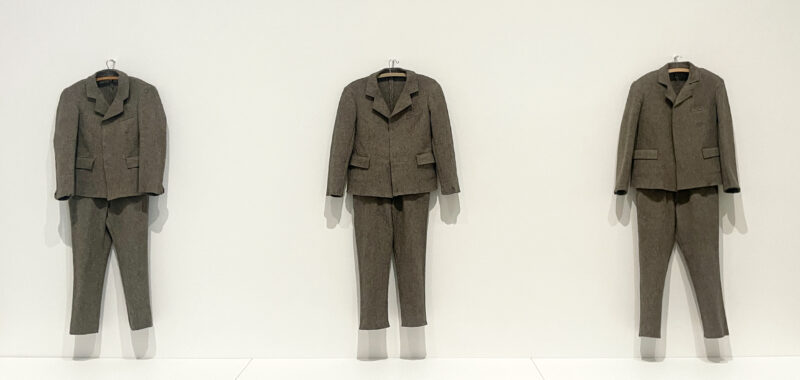LOS ANGELES — In the last few years, many artists and critics — often those who are White and male — have chastised the art world for being too focused on identity. Two include Dean Kissick, who recently complained in Harper’s that biennials were oversaturated in identity politics, and New York Magazine’s longtime critic Jerry Saltz, who in his 2016 oral history about how identity politics took over the art world, suggested that the movement was a modern trend.
A visit to Joseph Beuys: In Defense of Nature at the Broad, however, counters the idea that identity politics is a new phenomenon. The retrospective, mainly showcasing work made between the 1950s and 1970s, foregrounds a longstanding exploration of masculinity in the artist’s work. Through sculpture, performance, and ephemera, Beuys mocked stereotypically manly pursuits such as war, sport, and commerce.

Curators Andrea Gyordy and Sarah Loyer position the show as a reflection on Beuys’s environmental activism. He was a member of numerous conservation organizations, including Germany’s Green Party, and one of his monumental works, “7000 Oaks” (1982), consisted of planting 100 trees in Kassel, Germany, during documenta 7. But it was his multiples — mass-produced, affordable sculptures, often composed of everyday objects — and his “social sculpture,” a theory that reframed every mundane act of living as performance art, that stole my attention.
Three projects, “Schlitten” (Sled) (1969), “Beuys boxt für direkte demokratie” (Beuys boxes for direct democracy) (1972), and a set of multiples called Wirtschaftswertobjekte (Economic Value Objects) (1970s), foreshadow the emergence and preoccupations of the “manosphere,” a term that loosely groups together media, online communities, and figureheads, like Joe Rogan and Andrew Tate. Members of the manosphere consider themselves alpha males, or dominant, successful, and assertive — traits that they believe should be extinguished in women — and this is only achievable through the promotion of misogyny, male supremacy, and conservative values.
Upon entering the main gallery, the first object viewers encounter is “Schlitten,” a convincing replica of a World War II-era military sled. A felt blanket and flashlight are strapped to the device with tan utilitarian belts. The item is inspired by Beuys’s own military service, which ended with a plane crash in Crimea in 1944. He claimed that nomadic Tartars found him and kept him warm by wrapping him in fat and felt, which became two of his favorite materials over the course of his career.

The plane crash was documented, but the rescue story is probably a myth. Still, Beuys’s stolen valor became integral to his identity and output. This tactic continues today, especially among male politicians who exaggerate their military stories to uphold illusions of strength and bravery presumably befitting public office. For both Beuys and politicians, this strategy helps build careers, but caught in an exaggeration or a lie, only the artist can laugh it off as a conceptual exercise.
Beuys could also point to his military service and say it radicalized him against fascism. Even though he had his links to the Nazi party, which the show glosses over, he would cement himself as a leftist in “Beuys boxt für direkte demokratie.” In a bout that took place at documenta 5, the artist, advocating for a direct voting system, fought a local art student, Abraham David Christian, who was the stand-in for parliament. Beuys won.

A day after I saw this work, mansosphere influencer-turned-boxer Jake Paul took on an elderly Mike Tyson in a flashy fight that streamed on Netflix. It may as well have been called “Jake Paul boxes for fascism.” Just as Beuys’s boxing match served as a larger battle for what should be the reigning ideology, Paul has made himself a symbol for the new generation of right-wing alphas. The multimillionaire said he feared persecution for endorsing Trump mere days before he claimed victory in the ring.
Wirtschaftswertobjekte, a series that Beuys produced throughout the 1970s, is a proto-cryptocurrency that takes the forms of common grocery store items like cereal, milk cartons, and grocery bags. Beuys, who believed that one day creativity could be more valuable than money, scrawled “1 Wirtschaftswert” (1 Economic Value) on every object.

The concept bears a strong resemblance to NFTs, an intangible object represented by lines of code that aims to replace our current financial system. NFTs have been touted and hoarded by the manosphere as a way to escape regulation and government oversight, and also to protect influencers’ income streams when they are inevitably deplatformed for hate speech. But the resemblance ends there — Beuys’s currency was idealistic, intended to dismantle capitalism. For the crypto bro, NFTs, which are churned out by algorithms at the expense of creativity, are a high-tech way to enshrine capitalism among the masses.
Beuys tackled masculinity through humor and irreverence. The twist is that the subjects he parodied, which are nothing new, are increasingly an earnest fixation for an oppressive segment of the population that, as the 2024 election demonstrated, seems to be growing. Identity politics is not novel, and it can certainly be asserted by those who are white and male. We should look beyond the playfulness in In Defense of Nature and take it as a cautionary tale.


Joseph Beuys: In Defense of Nature continues at The Broad (221 South Grand Street, Downtown, Los Angeles) through March 23. The exhibition was organized by Sarah Loyer with Andrea Gyorody.

